What is MarTech: A complete guide to understanding marketing technology & how you can build a martech plan for your business
A Complete Guide to Understanding Martech, Step by Step Process Overview and Loads of Use Cases to Transform Your Business.
Create amazing product messaging, sales copy & email campaigns that excites your user to convert by capturing customer journeys at the acquisition phase.
The single most important thing you can do to drive growth in your business is to map your customer journey.
When done right, it can change how you view your entire business.
Start by capturing customer journeys at the acquisition phase and
create highly targeted personalized campaigns across your sales funnel, that touch your customer’s heart.
|
|
1. |
|
|
|
2. |
|
|
|
3. |
|
|
|
4. |
|
|
|
5. |
What is a leaking funnel and how to stop your funnel from leaking |
|
|
6. |
You don't need a fixed definition of Customer Journey to understand it because you are also a customer and know it better.
No matter if you own a brand, somewhere, you're also buying the products of other brands as their customers.
So, think like a customer instead of a business owner to get what your customer is expecting from you. You will not get it till the time you're not in their shoes.
In simple words, It’s a journey your customer takes right from the moment they first reach your website or landing page or an email, to the sales funnel and being your brand’s advocate.
Being aware of your customer's journey is essential.
A survey says that companies that have a customer-centric culture, are more likely to have loyal and happy employees.
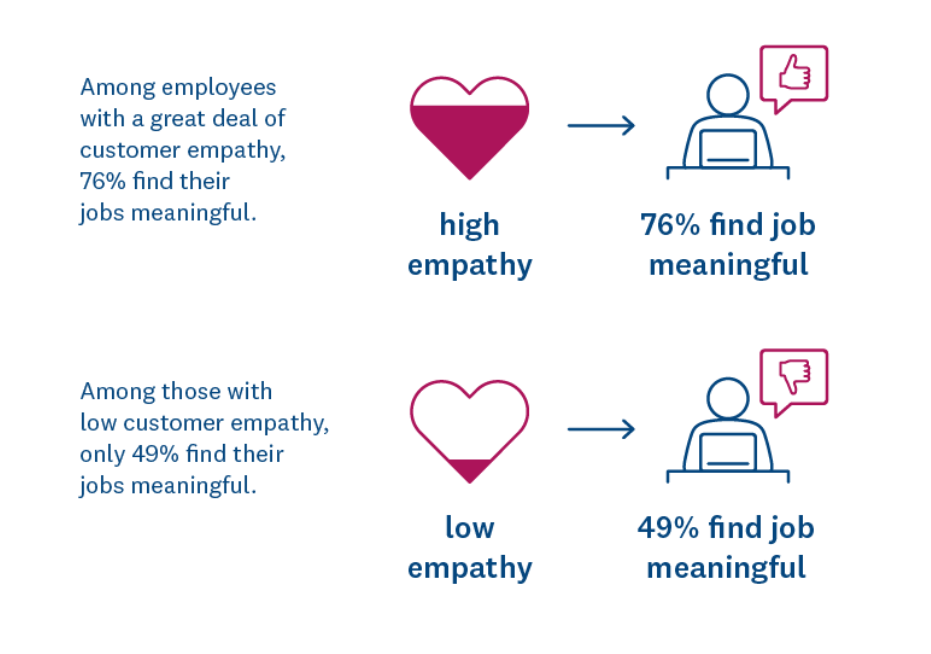
Think like this,
if you know what questions or thoughts your customer has in mind while browsing your website, you can provide relevant solutions to them at this particular time with the right medium.
For example: A user is trying to find why your product will suit them and what all will they get once they buy your product. You can set up a personalized flow for such types of users.
Here’s how it will look like:
Audience Segment: Second-time visitor, visited home, features & pricing pages, persona is a small-medium business, industry is ecommerce.
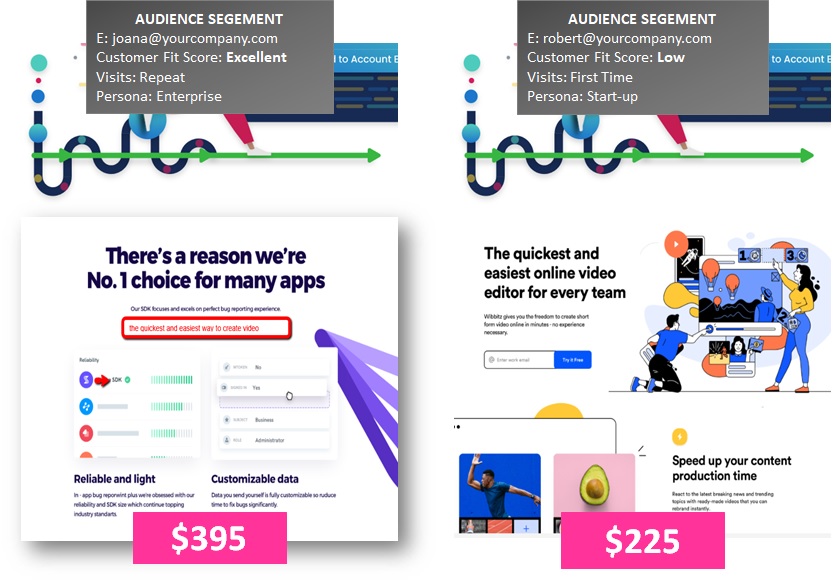
Chatbot Playbook: Send a pop-up message to that user which says:
Here’s a solution for your ecommerce store - link to a landing page which is specific to the user’s industry with all use cases, features, faq’s and a pricing table.
With personalization to this level, you can win your customers trust even before an actual sales person gets in touch with your prospect.
Using this approach, customers have seen a 5x increase in engagement and 70% more marketing qualified leads generated from live chat!
This power of a customer journey can change the way you see your customers.
Some things customer journey mapping helps you achieve:
Customer journey starts from touch points and then eventually evolves into a purchase. No one buys a product just after seeing it the first time.
Customers only buy a product after viewing it several times, researching about it, reading reviews and comparing with competitors.
These behavior tracking is called 'touchpoint,'
Which essentially means, the steps taken by a customer to convert.
This article highlights the importance of creating your first customer journey at the acquisition stage i.e. the first time when your customer visits your website or store.
Now that we understand the importance of a customer journey,
Let's create one for your business.
In simple words, visualizing your customer journey into a diagram to refer to it as a source in the future is known as an empathy map.
The best way to do it by imagining the way a customer is interacting with your business.
You can start on a simple spreadsheet and list down information under the following heads:
After analyzing these points, you need to combine them to visualize the average experience of your customers with your product.
Here’s an example empathy map for a typical b2b software development company:
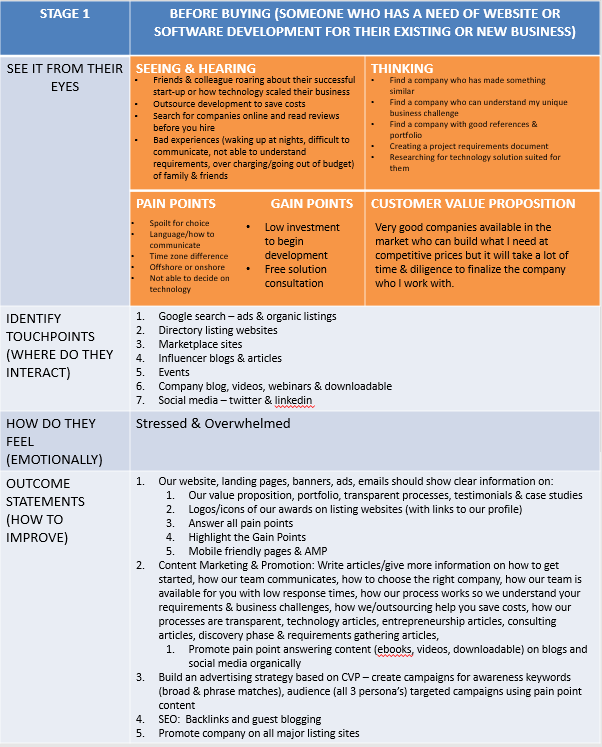
Such empathy maps needs to be created for three buying stages of the user:
This article explains the “before buying” stage.
After you create empathy maps for each buying stage, you will come up with certain outcomes which you should implement to build your final customer journey.
You will need to score each outcome based on:
You then need to split your outcomes into phases based on their opportunity score.
Here is how it will look like:
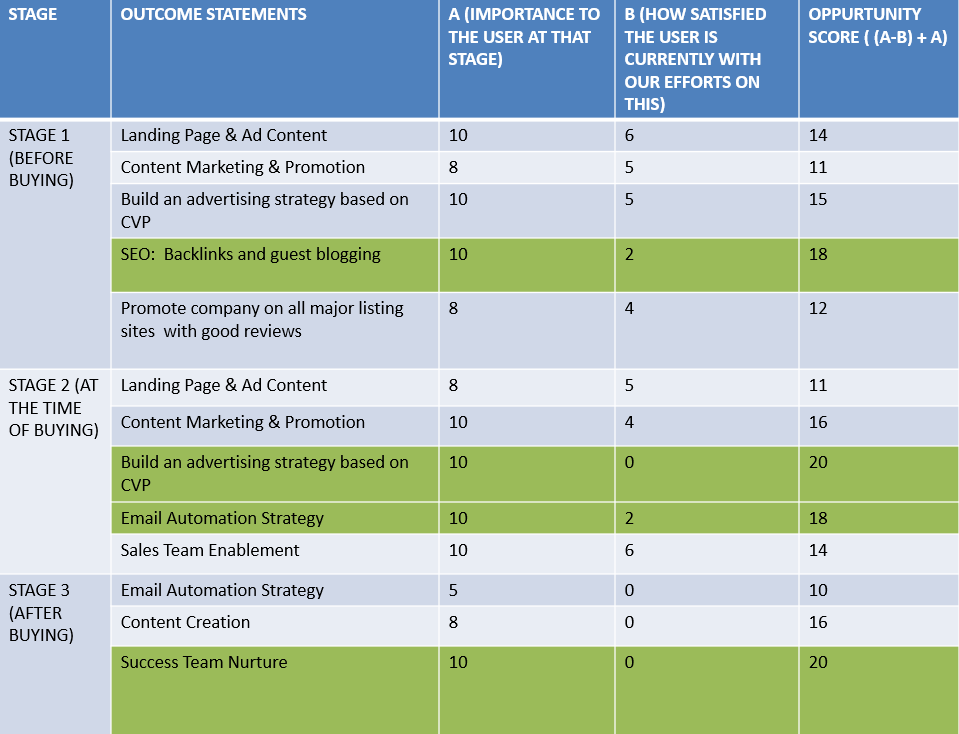
The green rows are the one with the most score and hence should be your very first focus.
In the above example you will see that by investing more time and money on things like:
Can get your base up to build your inbound growth strategy with specific messaging and to specific audiences.
Here is my free download of empathy map and opportunity score template for you. I’d like to share a filled in one with this example of a b2b software development company so you can use it as a reference.
Feel free to ask any questions in the comments below. Will be happy to help you out!
It takes a lot of analysis to get the whole idea of customer experience.
Empathy maps are a useful tool to put the customer's at the front and center in the business.
You understand your customer like never before.
Here I've mentioned all the steps you should do before creating an empathy map.
An empathy map is the first step towards building your customer journey.
The way I approach a customer journey is slightly different from what you would find in other blogs, but I guarantee that this way is more error-free and consistent….
First I will teach you the right thought process to build an empathy map - a creative thinking process,assuming all possibilities of your customer’s touchpoints and then matching it with your sales funnel - which finally makes it error-proof.
Let’s start...
STEP1. List Customers Pain Points
Go to your CRM and see the lost reasons, read those feedback surveys, check back with your service team for questions they ask, review all customers and prepare a list of reasons for why they did not convert.
Look up non-converting customer profiles and identify patterns that most of them resemble. Look for similarity in data points, to build your own type for a negative audience persona. Building this persona is important so you do not end up wasting your budgets on targeting users who would never convert.
STEP2. Collect Customer Feedback & Create Targeted Personas
In the second step, you need to start research by taking valuable feedback from your customers.
To conduct this research, you can create a questionnaire and user testing. It will help you to get useful and required customer feedback.
However, you don't need to get reviews or feedback from each customer.
Instead, you can opt a few prospects and customers who are your regular and loyal customers. If you're thinking why I'm saying this to do, then think about it like who all are your regular customers and will give you genuine feedback.
Create all different personas you're thinking about because it is essential to have customer feedback in different ways.
Each persona's experience will help to create various touchpoints because different feedbacks help you to understand better.
After creating a persona, you need to identify each phase to consider it to create a customer journey map.
You can ask these questions to yourself to know each phase:
Once you get the answers to these questions, you can consider them into your empathy maps
STEP3: Write Down All Your Acquisition Channels
Choosing the right acquisition channel is very important in building your customer journey.
Here are some acquisition channels for b2b businesses:
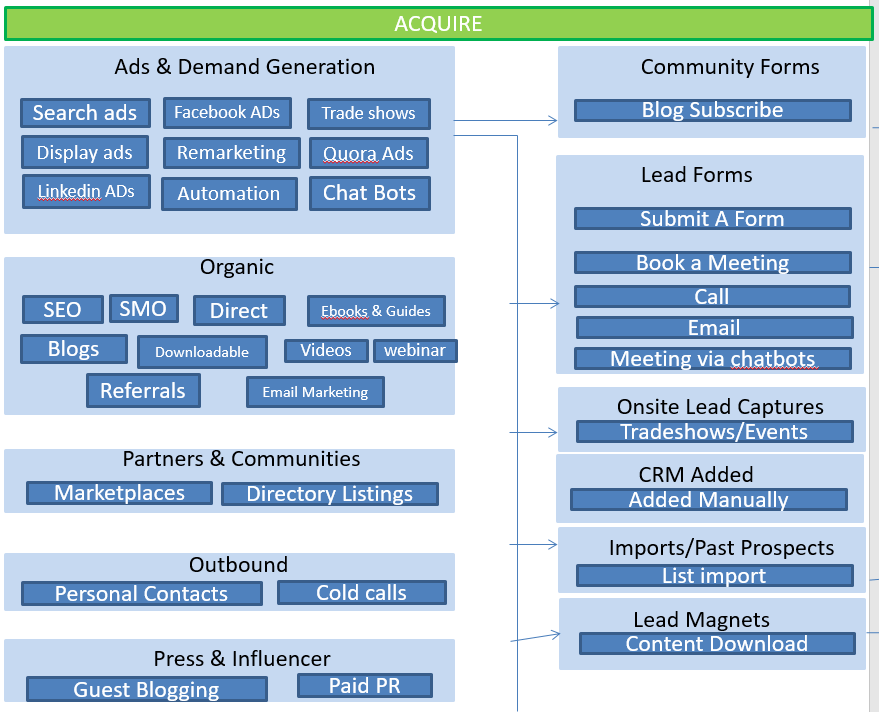
Step 4: Match Your Customer Journey With Your Sales Funnel
To make your customer journey error proof, map it with your sales funnel.
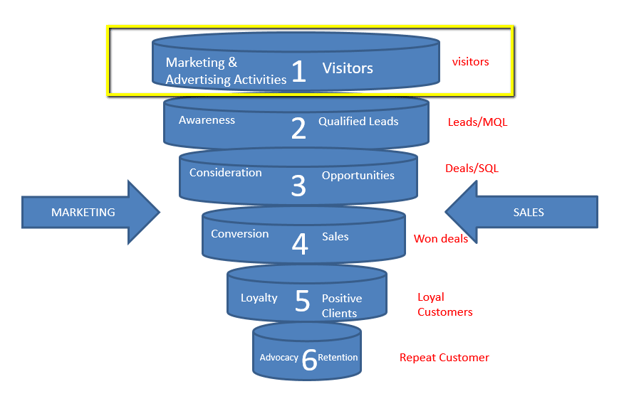
Step 5: Build a Separate Customer Journey For Every Acquisition Channel
Building a separate customer journey for every acquisition channel is helpful and important too.
So if your core acquisition channel is word of mouth, then your customer journey should be built to nurture the word of mouth channel.
You can identify influencers, your current customers and past customers and enrich them with information about your business which you want your new prospects to know.
The single most important thing you can do to drive growth in your business is to correctly map your customer journey.
If it gets done right, it can change whole game of your entire business.
Here is how your customer journey looks like: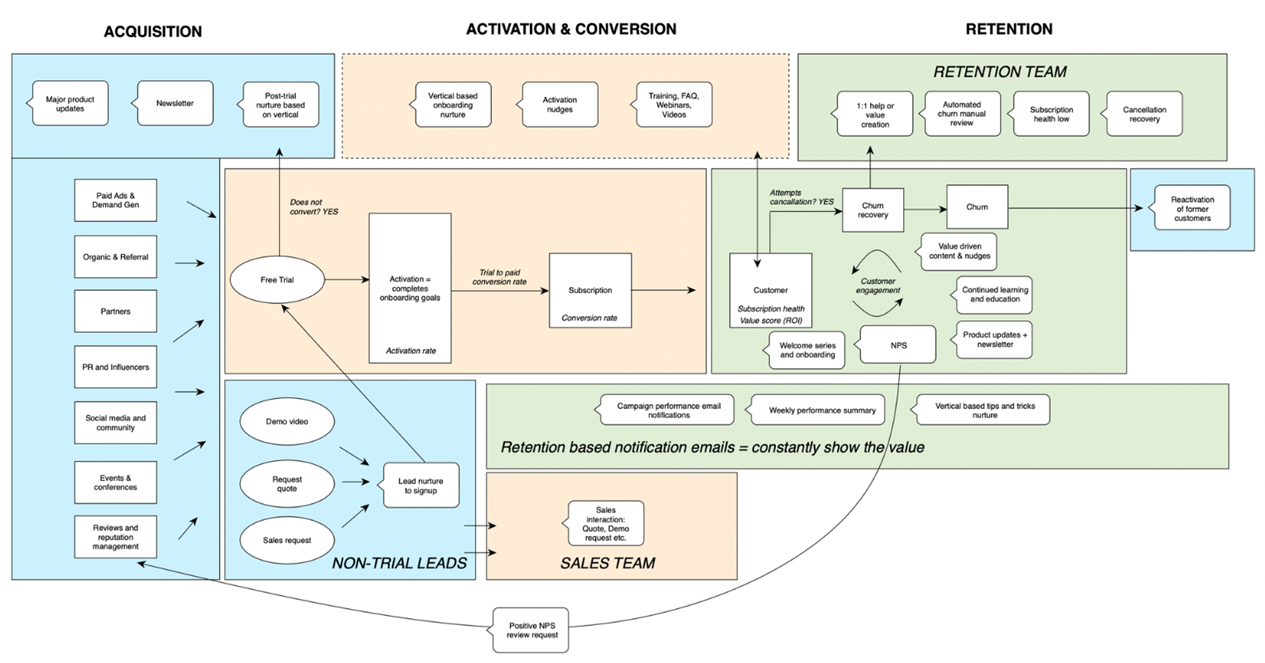
There are effectively 5 types of customer journey that you need to create:
You only need to build your inbound strategy for these 5 journeys and nothing else.
Here is my Growth Engine Framework, which i use to build an error proof customer journey and inbound strategy:
Here I will explain to you my acquisition framework, which even you can apply to your business.
Use a mix of channels to acquire customers.
For example if your large majority of the sign ups can come from word of mouth then your customer journey should be designed to support and grow this method of acquisition.
It goes without saying that if a new customer gets results, they will tell others.
Support this behavior with a journey which asks customers to submit a review to give a positive NPS rating.
Inversely if a customer decides to churn (and you are unable to retain them) consider this still as an acquisition opportunity.
They may not be suitable for your product today, but it doesn’t mean you can’t reactivate them in the future.
A reactivation journey continuously attempts to win back lost customers by reminding of the value of automating the customer journey.
Our goal in this phase is to get a new lead to try the product.
We would opt for calls-to-actions such as:
You still need to close the loop here back to the primary goal: getting them to try the product.
And to do this, we need a lead nurture journey that slowly nudges them towards the trial.
In cases where the trial ends without a conversion,
Users are brought back into the acquisition phase with a post-trial nurture with relevant content to inspire them to start a new trial.
Every subscriber you acquire is an opportunity to achieve your goal of increasing product trials.
To further support this phase you can send subscribers major product updates and email newsletters to stay top of mind.
To track the success of your journey, these are some of the metrics to look at:
Journeys that you need to create:
Campaigns that you need to run:
The best way to think through the acquisition phase is by using the "leaking bucket strategy".
Often we spend more time and money in acquiring new customers, but instead by just running highly targeted inbound campaigns, you can fix leads from leaking through the funnel that makes your funnel smaller towards the end.
By mapping the customer journey and the acquisition phase you will identify opportunities from patching leaks in your bucket.
It will give you a plan to execute in 2020 that you can get excited about and rally your team behind.
Here is how a leaking funnel looks like in a google analytics report.
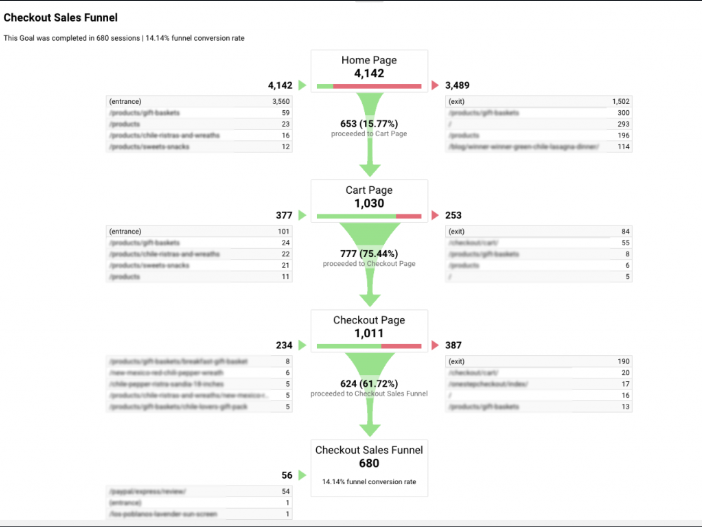
In the acquisition phase, you acquire 4142 users and at the same place you lose 3489 of those acquired users.
That's more than 80% of your leads wasted.
And if you spend $60 to acquire that lead, that means that you are wasting
$60 x 3489 = $209,340 every year
Every year you waste $200,000 on leads which you acquired.
This level of leaking budgets can bring a heavy lead to your ROI and especially in crisis situations such as pandemic we all are facing in 2020.
To summarize the above process, here are 5 steps to create your acquisition customer journey.
For the very first step, list down all of your acquisition channels if you’re using a mix of them. It will help you to figure out where you’re getting more effective leads.
You can understand which marketing and advertising efforts are converting with profitable converts, reduce churn and increase customer lifetime value.
Choose from these acquisition channels:
#2 List the journey that supports the acquisition process
Based on the empathy maps, you can really identify the journeys for every acquisition channel.
Once you have analyzed and figured out which journey and campaigns work for you and support the acquisition process, list them down.
Now, it’s time to communicate with your customers in the right way by contacting them frequently, but not suffocating them with aggressive or overwhelming contacts.
Every journey has different call to actions to perform.
For acquisition phase, following CTA’s are most effective:
We would opt for calls-to-actions such as:
You need to decide on the important metrics to track your business. Why? Because you need to cooperate with the right metrics to track your acquisition strategy.
To know which metrics will work for you best, start by deciding your goals clearly. Be simple with your goals instead of being dreamy as I have said earlier in this blog.
To track the success of your journey, these are some of the metrics to look at:
Once you get your right metrics you can build a useful sales funnel to get unique visitors. Focus on website conversion rates to understand whether it is working well for you or not. So, you should know if there is any leakage in your funnel to solve it immediately.
Also, don’t think that your metrics end here. Because you need to see cost per lead as well as customer lifetime value per channel to increase the success rate of your customer response rate.
You still need to close the loop here back to your primary goal that is getting leads to try your product.
You need to do this with a lead nurture journey that slowly nudges them towards the trial.
In cases where the trials end without a conversion, they need to be brought back into the acquisition phase with post-trial nurture with relevant content to inspire them to start a new trial.
So, if you’re not able to convert any lead into your customer or not able to retain any customer then don’t ignore them.
Take it as an opportunity because every subscriber or customer is important to you to achieve your goal.
At least they’re going to help you to increase the number of your product trials.
Don’t stop following them, do a regular follow up with them through an email newsletter, major product updates to stay in their mind regularly.
Applying these 5 steps will bring in strategies that will build trust with your customer.
I hope you find this useful. And if you do, write your comments below and feel free to share it with your peers who need it too.
Also, subscribe to my blog so you can get such amazing articles first - straight to your inbox.
All the best!
A Complete Guide to Understanding Martech, Step by Step Process Overview and Loads of Use Cases to Transform Your Business.
10 types of video-based growth strategies that will boost your brand, build trust with customers and create a social proof.
Build a solid digital foundation for your business with marketing and sales technology and understand what channel & medium works best for your...
Get Free Weekly Insights On How Performance Marketing Can Help Grow Your eComm